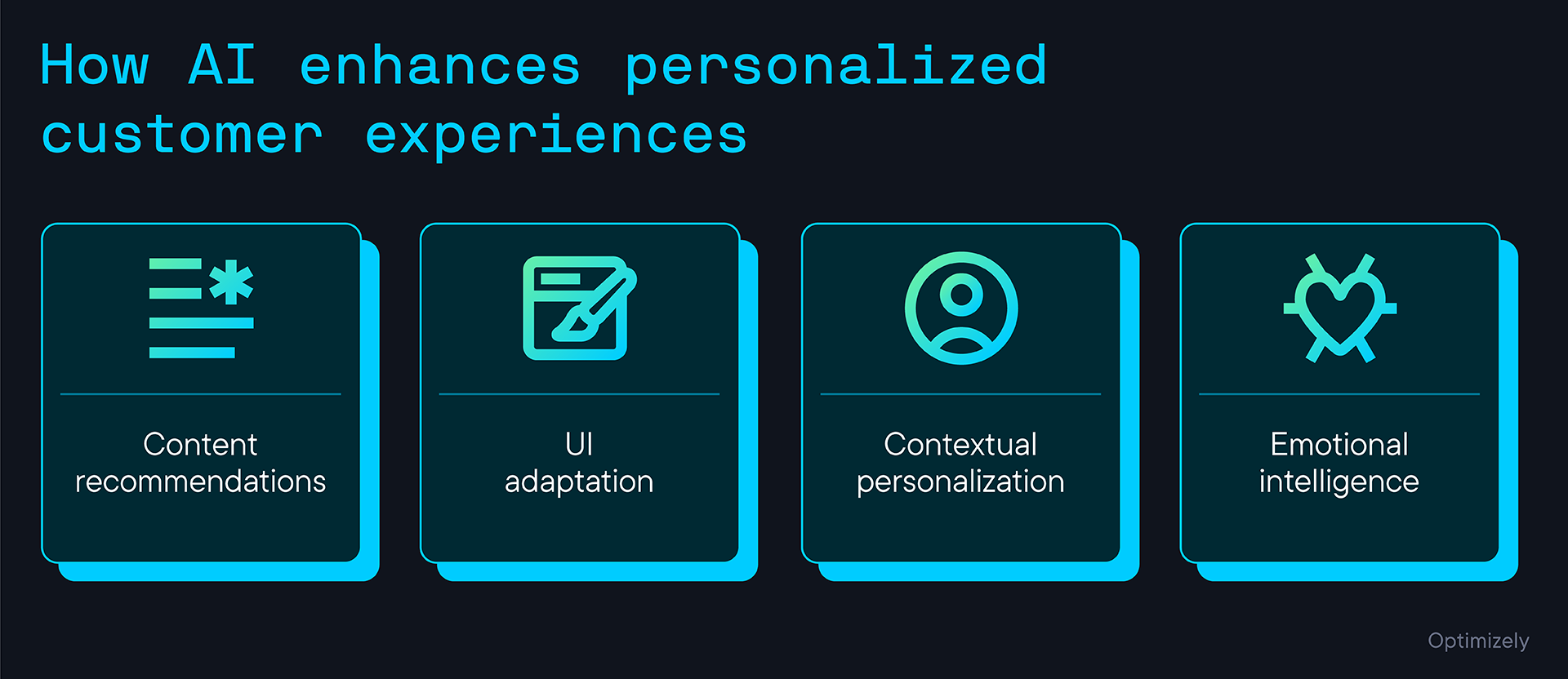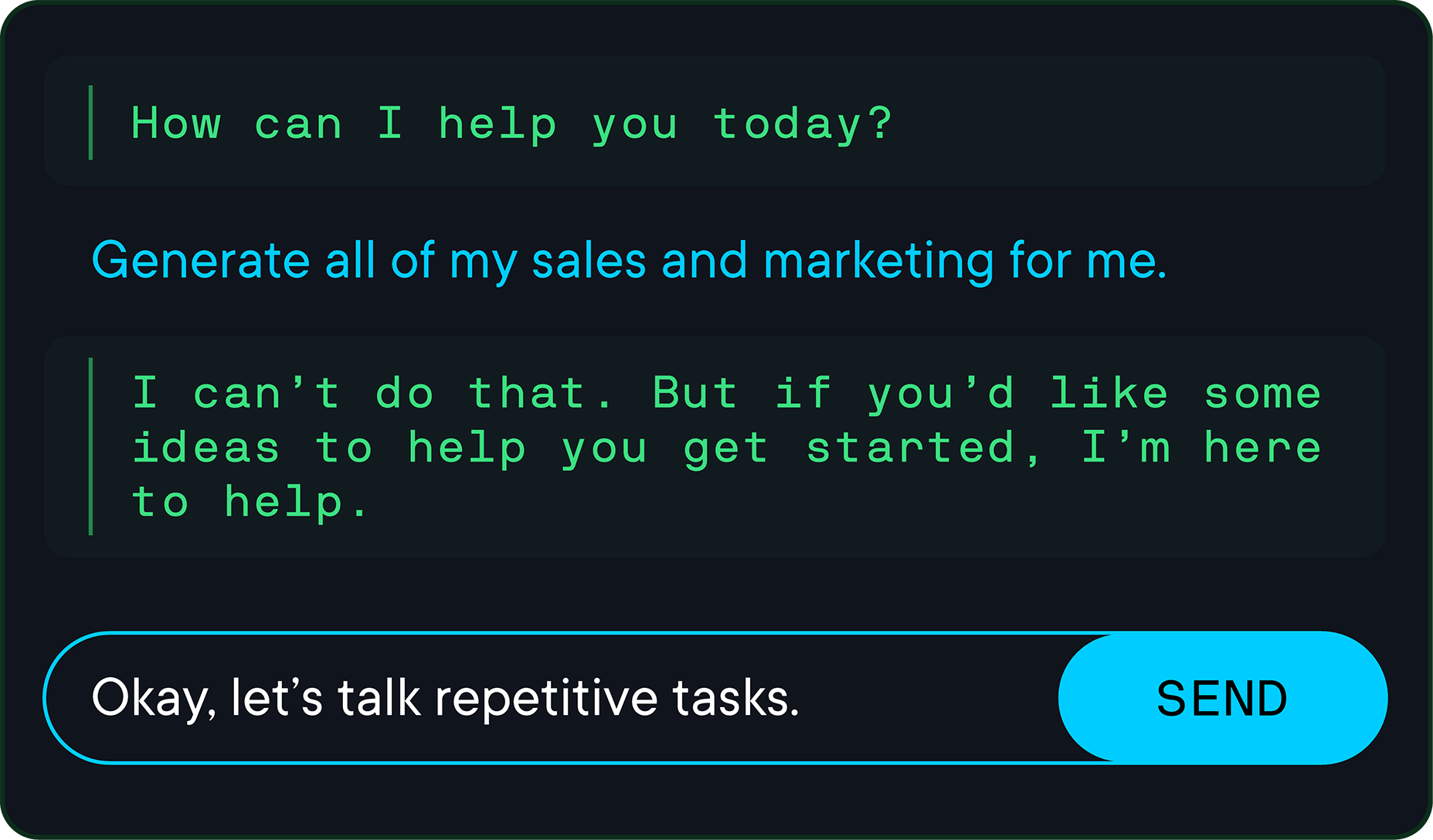AI knows us better than we do, which is why it's better at personalizing digital experiences than we are.
And let’s face it: If anyone truly “gets” you these days, it’s probably not your best friend, your spouse, or your coworkers... it’s your phone.
AI-powered personalization engines have become digital psychologists that understand our desires, predict our behavior, and anticipate our needs with a precision that often surpasses our own self-awareness
Whether you’re planning your personalization strategy, compiling the necessary data to execute your personalization strategy, creating the content that actually gets delivered, or adjusting the user journey in real-time, AI has become an indispensable component of personalization.
Here's why AI is better than us at delivering personalized experiences
- Adaptive learning
AI understands user behaviors in real-time - Rules-based personalization isn't scalable
AI is more efficient than manual segmentation - Predictive analytics and machine learning
Anticipating use behavior is the key to customer retention - Better ROI
AI drastically reduces marketing costs and improves conversion rates - Enhanced customer experience
AI understands humans as well as we do
AI employs adaptive learning
Customer experiences aren’t static. As users interact with your site, they’re either compelled to explore further or turned off completely.
For those that stick around, at some point, they’re going to have that a-ha moment where they’re ready to take the next step. Will you be there at the right time to usher them straight to that “contact us” button glowing like the tesseract?
Probably not.
Adaptive learning takes personalization a step further by creating dynamic, evolving user experiences. Unlike static recommendation systems, adaptive learning AI continuously refines its understanding of individual users.
Imagine a user browsing an ecommerce website. If you were standing over their shoulder, you’d easily be able to understand patterns, behaviors, and intents. This is essentially the role that AI is playing when observing user interactions on your site. AI is analyzing in real-time:
- Which products they pause on
- How long they view specific items
- Which details they zoom into
- Comparative browsing patterns
But that’s not all. AI engines also operate on the notion of contextual intelligence, meaning they’ll incorporate historical data as well as real-time behavior. This could include:
- Current time of day
- User's device
- Geographic location
- Recent search history
- Seasonal trends
These are crucial bits of data that AI can use to dynamically shape the customer experience. Instead of making product recommendations based on historical data alone, AI can capitalize on stronger, tangible signals like zooming into a product to understand what it is the user wants.
You need to be prepared to meet evolving customer needs as they unfold and relying on a pre-built system isn’t going to be fast enough, nor will it capture evolving user behavior in real-time.
Rules-based personalization isn’t scalable
Raise your hand if you’ve ever spent thousands on a home appliance, like a washer/dryer, only to be retargeted with ads or nurture emails showing you “similar items”... like other washer/dryers.
This embarrassing scenario can be avoided with a simple input of rules-based personalization. For example, you can manually set rules where each customer who purchased “item x” will then see product recommendations for “item y”.
But good luck doing that for every product on an ecommerce site, because rules-based personalization requires a lot of leg work and refinement. You need to have eyes on all segments at all times, while constantly validating data and information.
As your segments become more complex, the amount of work required to maintain your personalization engine will drastically increase. You’ll need to manually input every possible permutation of every possible customer journey. Sounds fun.
Predictive analytics and machine learning data processing
The beauty of AI is that it's not judging you... yet. AI skips your rationalizations and goes straight for the behavioral jugular. With every like, every rage click, and sheepish post-watch Google search, AI is connecting dots you didn’t know existed.
For example, ecommerce sites will leverage AI for:
- Predicting potential purchases before user searches
- Dynamically adjusting pricing and recommendations
- Creating personalized shopping journeys
How predictive analytics works
The process begins with comprehensive data collection. AI systems aggregate multiple data points:
- Clickstream data (exact pages and elements a user interacts with)
- Time spent on specific content
- Mouse movement patterns
- Previous purchase or interaction history
- Demographic and contextual information
Machine learning models then analyze these data points to:
- Identify behavioral patterns
- Create predictive models of user preferences
- Generate real-time personalization strategies
If you’re like most companies, your data is literally everywhere being collected literally all the time. You have data on your site, on social media, in data warehouses, on various platforms, etc. With a connected platform, AI can aggregate all that data instantly to predict customer behavior and accurately assess customer needs and wants.
Better ROI
Online shoppers are more likely to visit and make a purchase on a site that offers personalized recommendations. On top of that, personalization can deliver up to 800% ROI on marketing spend while boosting sales 10%. And AI is the primary driver to help you realize these results even faster. Here’s how:
Increased conversion rates
Ecommerce sites that have already implemented advanced personalization are seeing conversion rates increase anywhere from 10-30%. AI is able to execute scaled personalization in milliseconds by:
- Presenting the most relevant products to individual users
- Reducing friction in the customer journey
- Creating more compelling, targeted experiences
Optimized marketing spend
Companies relying on AI for personalization have a much better understanding of their customers' wants and needs than companies that do not. And this is because AI is collecting, analyzing, and actioning data in a fraction of a second, while simultaneously delivering meaningful customer experiences with
- More precise customer targeting: Real-time segmentation means AI is keeping up with evolving customer segments and analyzing more complex datasets to build out wider customer profiles
- Reduced wasted advertising expenditure: With better targeting comes better ROAS
- Automated, intelligent marketing processes: As AI better understands patterns and behaviors, AI agents can execute automation processes that typically eat up tons of resources
Yea, employing AI will absolutely cost more in an initial outlay. But the time you’ll save not combing through data, creating all that content yourself (like reshaping landing pages for each industry you’re targeting.
Enhanced user experience
Personalization is all about enhancing the user experience, and AI is the best way to accelerate customer satisfaction. In fact, 86% of customers are willing to pay more for an excellent customer experience.
Here are some ways AI can help digital marketers deliver amazing user experiences:

Content recommendations
AI algorithms analyze user behaviors to surface relevant content at the perfect moments.
- Streaming platforms like Netflix use AI to suggest movies and shows based on viewing history
- Ecommerce sites recommend products aligned with individual shopping patterns
- News apps curate personalized news feeds that match a user's interests
User interface adaptation
When it comes to features and customer interactions, users tend to favor certain features and layouts over others. For example, users who are visually impaired may prefer web layouts with higher contrast and larger fonts. AI can dynamically adjust user interfaces to improve individual user experience by:
- Rearranging app layouts based on frequently used features
- Adapting color schemes and design elements to user preferences
- Simplifying navigation for users with different skill levels or accessibility needs
Contextual personalization
AI can incorporate contextual information to enhance personalization by:
- Adjusting recommendations based on time of day, location, or device
- Providing weather-appropriate suggestions
- Offering culturally relevant content
Emotional intelligence
There’s already growing evidence that AI is more empathetic and has a better understanding of humans than we do. If that scares you, it shouldn’t. Actually, it should excite you.

AI is trained to overcome implicit biases (well, most of the time), to provide a consistently empathetic, patient response to users. With AI, you don’t have to worry about emotional taxation. Which is why AI so powerful at:
- Recognizing user emotional states
- Adapting communication style accordingly
- Providing empathetic and contextually appropriate responses
The key is creating personalization that feels helpful and intuitive rather than invasive, ultimately making digital experiences more efficient, enjoyable, and meaningful for individual users. AI is going to build customer loyalty by giving them a more relevant customer experience.
Wrapping up
Websites and apps are beyond the threshold of blanket optimization and broad personalization. The dynamic nature of evolving customer behavior means you not only need to adapt in milliseconds, you need to be able to accurately predict customer behavior before it occurs.
AI is the only tangible solution to ensuring you can hit these benchmarks. Letting AI do all the work for you is the simplest way to ensure that you’re being met with customers who are actually excited to speak with you.
- Last modified: 7/31/2025 11:18:17 PM
